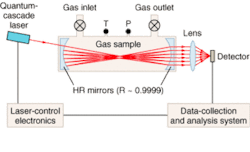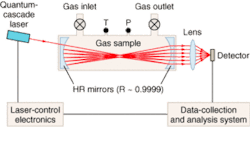QC laser–based spectrometer flies high
Los Gatos Research (Mountain View, CA) has teamed up with Jim Podolske from NASA Ames (Mountain View, CA) to flight-test a new technology that has provided the first ultrasensitive in situ carbon monoxide (CO) measurements in the troposphere and stratosphere using a quantum-cascade laser. The system provides trace-gas analysis at concentrations from 0.2 to 2000 parts per billion volumetric (ppbv), with sensitivity better than 0.2 ppbv at 1 Hz and accuracy better than 1%. The entire system was mounted on a DC-8 aircraft and flown for a weeklong study.
The system combines a quantum-cascade laser and cavity-enhanced laser-absorption spectroscopy; unlike traditional cavity-ringdown-spectroscopy setups, the system is completely autonomous. Throughout the series of flights, the optical alignment never needed to be adjusted—important for operation on UAVs (unmanned aerial vehicles).
"The combination of mid-IR QC lasers and off-axis ICOS (integrated-cavity-output spectroscopy) has produced an instrument with outstanding sensitivity and selectivity for CO," said Podolske after the in-flight trial. "I was impressed with how quiet the CO signal was, even as we passed through areas of moderately strong turbulence. There was no evidence of mechanical vibration affecting the measurements."
While CO is a key component of ground-based smog, NASA has other interests in its detection. Because CO has a lifetime of one to three months, it is a useful tracer for studying the transport of air from the troposphere to the stratosphere across the tropopause boundary.
The system incorporates a single-mode cryogenically cooled continuous-wave (CW) tunable narrow-bandwidth quantum-cascade laser operating near 4.6 µm, as well as an ultralong-path-length high-finesse optical cavity (see figure). Engineers designed a simple alignment-free cavity with highly reflective curved mirrors that uses ICOS. The absorption signal is obtained by temporal integration of the laser intensity transmitted through the cavity.
Because the laser is placed off-axis and is not optically mode-matched to the cavity, there are no alignment issues. The high (greater than 99.99%) reflectivity of the mirrors leads to thousands of passes through the cavity and an effective path length on the order of 1 to 100 km. The transmitted laser intensity depends on several knowable quantities, including laser intensity, mirror reflection, transmission coefficients, and the cavity-ringdown decay time. The intensity and decay time can be monitored as the laser is tuned through different wavelengths. When the wavelength matches the absorption of a particular species (CO in this case), the change in the laser intensity is recorded. Integrated microprocessors then convert this to an absolute concentration based on in-situ pressure and temperature measurements.
Measuring CO in situ has challenges other than in-flight turbulence; resolving the absorption spectra is also an issue, requiring line widths on the order of a few megahertz to distinguish the CO absorption from the nearby absorption from nitrous oxide. Compared with standard Fourier-transform IR (FTIR) spectroscopy, off-axis ICOS yields high-resolution spectra that allow quantitative measurements in spectrally congested regions, so there isn't any competition from absorption of other gases. In addition, this technique is several orders of magnitude faster than traditional FTIR.
Lori Howe is a freelance writer living in Mountain View, CA; e-mail: [email protected].

